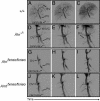Gestational exposure of Ahr and Arnt hypomorphs to dioxin rescues vascular development
- PMID: 15545609
- PMCID: PMC534507
- DOI: 10.1073/pnas.0404379101
Gestational exposure of Ahr and Arnt hypomorphs to dioxin rescues vascular development
Abstract
The aryl hydrocarbon receptor (AHR) is commonly known for its role in the adaptive metabolism of xenobiotics and in the toxic events that follow exposure to 2,3,7,8-tetrachlorodibenzo-p-dioxin (dioxin). Previously, we have demonstrated that the AHR and its heterodimeric partner, the AHR nuclear translocator (ARNT), play a role in the developmental closure of a hepatic vascular shunt known as the ductus venosus (DV). To investigate the mechanism of DV closure, we generated hypomorphic alleles of the Ahr and Arnt loci. Using these models, we then asked whether this vascular defect could be rescued by receptor activation during late development. By manipulating gestational exposure, the patent DV in AHR or ARNT hypomorphs could be efficiently closed by dioxin exposure as early as embryonic day 12.5 and as late as embryonic day 18.5. These findings define the temporal regulation of receptor activation during normal ontogeny and provide evidence to support the idea that receptor activation and AHR-ARNT heterodimerization are essential for normal vascular development. Taken in the broader context, these data demonstrate that similar AHR signaling steps govern all major aspects of AHR biology.
Figures




Similar articles
-
Patent ductus venosus and dioxin resistance in mice harboring a hypomorphic Arnt allele.J Biol Chem. 2004 Apr 16;279(16):16326-31. doi: 10.1074/jbc.M400784200. Epub 2004 Feb 5. J Biol Chem. 2004. PMID: 14764592
-
Aryl hydrocarbon receptor expression and activity in cerebellar granule neuroblasts: implications for development and dioxin neurotoxicity.Toxicol Sci. 2005 Feb;83(2):340-8. doi: 10.1093/toxsci/kfi031. Epub 2004 Nov 10. Toxicol Sci. 2005. PMID: 15537747
-
Conditional disruption of the aryl hydrocarbon receptor nuclear translocator (Arnt) gene leads to loss of target gene induction by the aryl hydrocarbon receptor and hypoxia-inducible factor 1alpha.Mol Endocrinol. 2000 Oct;14(10):1674-81. doi: 10.1210/mend.14.10.0533. Mol Endocrinol. 2000. PMID: 11043581
-
Mechanisms of ligand-induced aryl hydrocarbon receptor-mediated biochemical and toxic responses.Toxicol Pathol. 1998 Sep-Oct;26(5):657-71. doi: 10.1177/019262339802600510. Toxicol Pathol. 1998. PMID: 9789953 Review.
-
AhR and ARNT modulate ER signaling.Toxicology. 2010 Feb 9;268(3):132-8. doi: 10.1016/j.tox.2009.09.007. Epub 2009 Sep 22. Toxicology. 2010. PMID: 19778576 Review.
Cited by
-
The molecular basis for differential dioxin sensitivity in birds: role of the aryl hydrocarbon receptor.Proc Natl Acad Sci U S A. 2006 Apr 18;103(16):6252-7. doi: 10.1073/pnas.0509950103. Epub 2006 Apr 10. Proc Natl Acad Sci U S A. 2006. PMID: 16606854 Free PMC article.
-
The role of endogenous aryl hydrocarbon receptor signaling in cardiovascular physiology.J Cardiovasc Dis Res. 2011 Apr;2(2):91-5. doi: 10.4103/0975-3583.83033. J Cardiovasc Dis Res. 2011. PMID: 21814412 Free PMC article.
-
Association of Rs339939442 in the AHR Gene with Litter Size are Inconsistent among Chinese Indigenous Pigs and Western Commercial Pigs.Animals (Basel). 2019 Dec 19;10(1):11. doi: 10.3390/ani10010011. Animals (Basel). 2019. PMID: 31861561 Free PMC article.
-
A hypomorphic allele of aryl hydrocarbon receptor-associated protein-9 produces a phenocopy of the AHR-null mouse.Mol Pharmacol. 2008 Nov;74(5):1367-71. doi: 10.1124/mol.108.047068. Epub 2008 Jul 31. Mol Pharmacol. 2008. PMID: 18669605 Free PMC article.
-
Aryl hydrocarbon receptor-dependent liver development and hepatotoxicity are mediated by different cell types.Proc Natl Acad Sci U S A. 2005 Dec 6;102(49):17858-63. doi: 10.1073/pnas.0504757102. Epub 2005 Nov 21. Proc Natl Acad Sci U S A. 2005. PMID: 16301529 Free PMC article.
References
-
- Schmidt, J. V. & Bradfield, C. A. (1996) Annu. Rev. Cell Dev. Biol. 12, 55–89. - PubMed
-
- Whitlock, J. P., Jr., Chichester, C. H., Bedgood, R. M., Okino, S. T., Ko, H. P., Ma, Q., Dong, L., Li, H. & Clarke-Katzenberg, R. (1997) Drug Metab. Rev. 29, 1107–1127. - PubMed
-
- Poland, A. & Knutson, J. C. (1982) Annu. Rev. Pharmacol. Toxicol. 22, 517–554. - PubMed
-
- Gu, Y.-Z., Hogenesch, J. & Bradfield, C. (2000) Annu. Rev. Pharmacol. Toxicol. 40, 519–561. - PubMed
-
- Hankinson, O. (1995) Annu. Rev. Pharmacol. Toxicol. 35, 307–340. - PubMed
Publication types
MeSH terms
Substances
Grants and funding
LinkOut - more resources
Full Text Sources
Molecular Biology Databases

